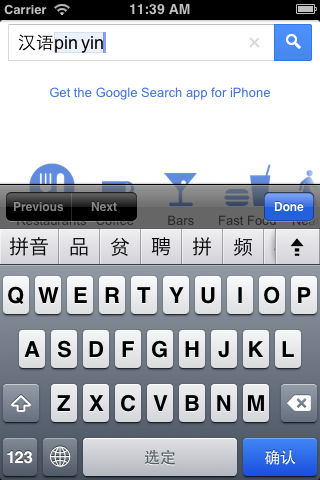Pinyin: A Beginner’s Guide

When I first decided to move to China, I was really nervous about trying to learn a language with no alphabet. How would I learn to pronounce each character? Would I ever remember the tones?
Luckily, there’s a simple tool used by Mandarin learners around the world (as well as hundreds of millions of Chinese school kids) to pronounce Chinese characters: 拼音 (pīn yīn)![]() – known simply as “pinyin” in English.
– known simply as “pinyin” in English.
Beginners use pinyin to get used to the sounds and tones of Mandarin, while more advanced learners can use it to look up new words they’ve heard out loud in the dictionary, and type Chinese characters using a standard keyboard.
In fact, if you’ve said the words “Beijing” or “Shanghai” out loud before, you’ve already used pinyin without even knowing it!

拼音 (pīn yīn)![]() is a tool, not a language
is a tool, not a language
Pinyin is a tool for writing Chinese in the Latin alphabet (the alphabet used by English and most European languages).
Let’s take my adoptive city of 上海 (shàng hǎi)![]() – Shanghai as an example.
– Shanghai as an example.

In Chinese characters, Shanghai is written 上海. The pinyin – shàng hǎi – tells you how to pronounce those characters.
Likewise, 北京 (the characters for Beijing) is written in pinyin as “běi jīng”![]() .
.
Simple, right?
You might be wondering why Chinese people don’t just use pinyin, given how much easier it is to learn than the literally tens of thousands of Chinese characters.
Well, Chinese has a huge number of words that sound alike, which means understanding a full article or book in pinyin would be super difficult.
For example, in pinyin the given name of the hugely respected former Chinese leader 邓小平 (dèng xiǎo píng)![]() – Deng Xiaoping is written exactly the same as 小瓶 (xiǎo píng)
– Deng Xiaoping is written exactly the same as 小瓶 (xiǎo píng)![]() – which means “small bottle”. An important distinction!
– which means “small bottle”. An important distinction!
While pinyin is a great pronunciation tool, it’s not a good strategy for reading Chinese in the long term.
拼音 (pīn yīn)![]() for new Chinese learners
for new Chinese learners
But, when you’re starting your Chinese learning journey, pinyin is absolutely indispensable for getting used to the sounds of Mandarin, and for learning to say basic words and sentences. It’s the very first thing you should learn in Chinese.
That’s why Yoyo’s Beginner Conversational Course focuses hard on pinyin at the beginning. If you get pronunciation right from the start, you’ll quickly be able to learn to pronounce new words later on in your studies.
Incidentally, you might see the same word written in pinyin in slightly different ways. For example, 上海 (shàng hǎi)![]() could also be written “Shànghǎi” or simply “Shanghai”.
could also be written “Shànghǎi” or simply “Shanghai”.
Yoyo’s courses separate each pinyin sound instead of combining them into compounds, because that’s how real written Chinese works. Written Chinese doesn't separate compound words from each other or have "capitalization", and treating pinyin this way sometimes leads students to rely on it too much.
Think of pinyin like a walking cane for Chinese language learning – it’s not a language, but a tool to help you master the pronunciation of Chinese characters.
When to start learning Chinese characters
Some learners are super eager to start learning to read and write Chinese’s artful, elegant characters - 汉字 (hàn zì) ![]() . Others would prefer to stick with pinyin forever. So, when is the right time?
. Others would prefer to stick with pinyin forever. So, when is the right time?
Personally, I started out (years ago) trying to learn characters alongside pinyin, but back when I was unfamiliar with how the Chinese language works I really struggled to learn new sounds, meanings and writing simultaneously.
I’d recommend starting to read Chinese characters after you have a basic foundation for the spoken language. If you're taking the courses here on Yoyo Chinese, when you reach Level 2 of the Beginner Conversational Course, you're ready to start the Chinese Character Course.
The fact is: it’s much easier to learn to read and write characters once you already know the sound and meaning of the words.
Once you start learning characters, pinyin becomes just a pronunciation hint to help recognize the characters. That means that while reading, you should be concentrating on the characters, not the pinyin (focus attention on “上海” not “shàng hǎi”). That way, you’ll become familiar with how characters look as well as how they sound.
Is there a right time to stop using pinyin?
Native Chinese speakers almost never use pinyin to communicate after learning it at the beginning of school, and you’ll never see a Chinese newspaper, website or book written in pinyin.
That means that once you’re at the intermediate level, I’d recommend aiming to read Chinese sentences without any pinyin. That way you’ll learn the language as a native speaker does.
But, that doesn’t mean giving up pinyin altogether. I use it almost every day to type in Chinese, and to look up the characters for new words I’ve heard aloud in the dictionary. Check out our guide for typing in Chinese on any device if you don't already have a Chinese input on your phone, computer, or tablet.

Have any more questions about pinyin, or about learning Chinese in general? Let us know in the comments section, we’d love to hear from you!

 PIPPA MORGAN | APRIL 03, 2018
PIPPA MORGAN | APRIL 03, 2018

 Chinese Is Easier Than You Think
Chinese Is Easier Than You Think What Is Pinyin?
What Is Pinyin? An Introduction to the Tones
An Introduction to the Tones The 1st and 2nd Tones
The 1st and 2nd Tones Numbers 0-10
Numbers 0-10 Learn Chinese Pronunciation RIGHT with the (FREE!) Yoyo Chinese Interactive Video & Audio Pinyin Chart
Learn Chinese Pronunciation RIGHT with the (FREE!) Yoyo Chinese Interactive Video & Audio Pinyin Chart [LIVE] How to Read a Chinese Menu 101
[LIVE] How to Read a Chinese Menu 101 [LIVE]: How Chinese People Actually Speak
[LIVE]: How Chinese People Actually Speak Did You Know You Can Use Yoyo Chinese Like a Mobile App?
Did You Know You Can Use Yoyo Chinese Like a Mobile App? Why do non-Chinese people feel that Chinese is difficult to learn?
Why do non-Chinese people feel that Chinese is difficult to learn? An Untold Love Story of Me and Yoyo Chinese
An Untold Love Story of Me and Yoyo Chinese  6 Awesome Authentic Chinese Foods You Need to Know About
6 Awesome Authentic Chinese Foods You Need to Know About Frequently Asked Questions About Chinese
Frequently Asked Questions About Chinese  5 Things Chinese Women Love About Western Men
5 Things Chinese Women Love About Western Men Chinese Insults: How to Name-Call Like a Pro (Part 1)
Chinese Insults: How to Name-Call Like a Pro (Part 1) Tone Pairs - The Mandarin Language Hack You've Been Waiting For
Tone Pairs - The Mandarin Language Hack You've Been Waiting For